

Product Owner Checklist. This brief checklist helps you remember the most important things to become a good Product Owner.
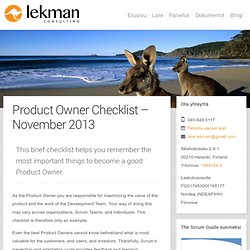
As the Product Owner you are responsible for maximizing the value of the product and the work of the Development Team. Your way of doing this may vary across organizations, Scrum Teams, and individuals. This checklist is therefore only an example. Even the best Product Owners cannot know beforehand what is most valuable for the customers, end users, and investors. Xavier Quesada explicando el rol del PO en el CSPO.
Www.stickyminds.com/sites/default/files/presentation/file/2013/11ADPWR_KT2.pdf. Www.stickyminds.com/sites/default/files/presentation/file/2013/11ADPWR_AT4.pdf. Demystifying the Role of Product Owner. FAQ: How Can I Be a Better Product Owner? The Essential Product Owner—Championing Successful Products: An Interview with Ellen Gottesdiener. Ellen Gottesdiener will be presenting a presentation titled "The Essential Product Owner: Championing Successful Products" at the Agile Development Conference and Better Software Conference West 2014, which will take place June 1–6, 2014.
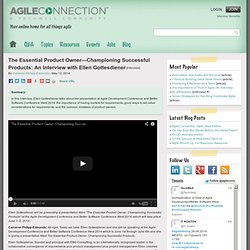
Cameron Philipp-Edmonds: All right. Today we have Ellen Gottesdiener and she will be speaking at the Agile Development Conference and Better Software Conference West 2014 which is June 1st through June 6th and she is giving a presentation titled The Essential Product Owner: Championing Successful Products. Ellen Gottesdiener, founder and principal with EBG Consulting, is an internationally recognized leader in the collaborative convergence of requirements plus product management plus project management.
Ellen coaches and trains individuals and teams and facilitates discovery and planning workshops across diverse industries. She writes widely and speaks to conferences worldwide. Ellen Gottesdiener: Discover to Deliver. Ellen: No. Cameron: Okay. How to make a good Product Owner - Adam Cogan's Blog. Posted: September 13th, 2013 | Author: Adam Cogan | Filed under: General, Scrum | 4 Comments » How do we make good Product Owners At my Teched talks this month (Australia and New Zealand) I talked about Product Owners.
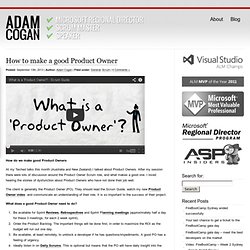
After my session there were lots of discussion around the Product Owner Scrum role, and what makes a good one. I loved hearing the stories of dysfunction about Product Owners who have not done their job well. Common Product Owner Traps. Product owners play a key part in creating successful products with Scrum: They are in charge of the product and lead the development effort.
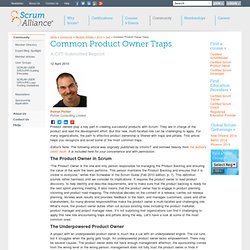
But this new, multi-faceted role can be challenging to apply. For many organizations, the path to effective product ownership is littered with traps and pitfalls. This article helps you recognize and avoid some of the most common traps. Editor's Note: The following article was originally published by InformIT and borrows heavily from the author's latest book. It is included here for your convenience and with permission. 11 Reglas para administrar el Product Backlog en Scrum. En el marco de trabajo Scrum, el "Product Backlog" es el artefacto metodológico utilizado para listar las características (Features) o Funcionalidades del software a desarrollar, para priorizarlas de acuerdo a la solicitud del área de negocio.
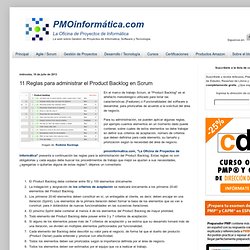
Para su administración, se pueden aplicar algunas reglas, por ejemplo cuantos elementos en un momento dado puede contener, sobre cuales de estos elementos se debe trabajar en definir sus criterios de aceptación, número de criterios que deben definirse para cada elemento, su tamaño y priorización según la necesidad del área de negocio. pmoinformatica.com, "La Oficina de Proyectos de Informática" presenta a continuación las reglas para la administración del Product Backlog.
Estas reglas no son obligatorias y cada equipo debe buscar los procedimientos de trabajo que mejor se ajusten a sus necesidades, ¿agregarías o quitarías alguna de estas reglas? , déjanos un comentario. Forrester State of Product Delivery - Confirmation. The difference between a product manager and a product owner. “The product manager’s job is to oversee all aspects of a product or service line to create and deliver superior customer satisfaction while simultaneously providing long-term value for the company,” writes Linda Gorchels in the third edition of The Product Manager’s Handbook.

This sounds similar to Ken Schwaber’s description of the product owner role in the Scrum Guide: “The Product Owner is the (…) person responsible for (…) ensuring the value of the work the team performs.” Ken Schwaber's Blog: Telling It Like It Is. FAQ on Career Path of Scrum Product Owners for Management. As Agile and Scrum grows deeper into the market it is valuable for Management to communicate the rewarding and desirable career path that a Scrum Product Owner can have… even beyond just leading single Scrum Product Teams.
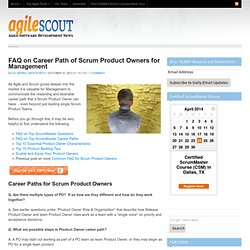
Before you go through this, it may be very helpful to first understand the following: Career Paths for Scrum Product Owners Q. Are there multiple types of PO? If so how are they different and how do they work together? A. Q. A. The Product Owner Responsibilities. Scope: Product, Feature, or Component Owner?
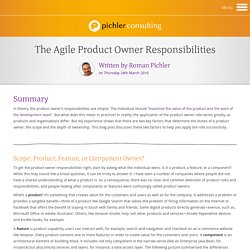
To get the product owner responsibilities right, start by asking what the individual owns. Is it a product, a feature, or a component? While this may sound like a trivial question, it can be tricky to answer it: I have seen a number of companies where people did not have a shared understanding of what a product is. Mastering Common Product Owner Challenges.
Applying the product owner role can be challenging.
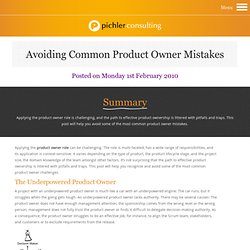
The role is multi-faceted, has a wide range of responsibilities, and its application is context-sensitive: It varies depending on the type of product, the product lifecycle stage, and the project size, the domain knowledge of the team amongst other factors.